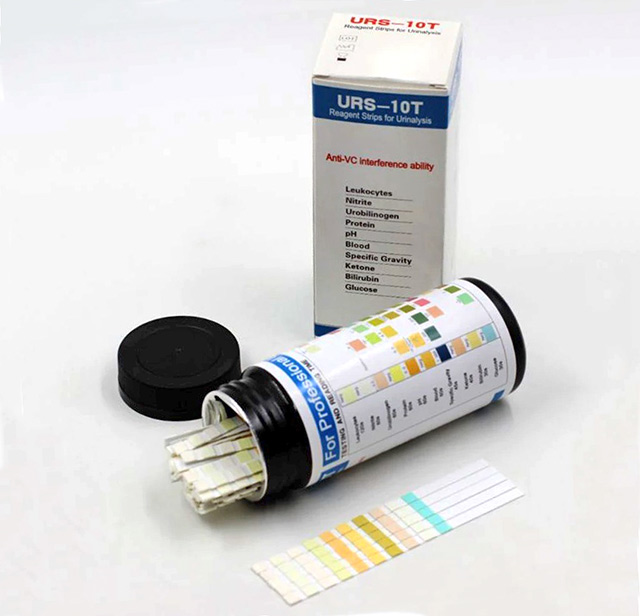A urine test can be used to determine the presence of certain substances in the urine which can help in the diagnosis of certain diseases. A simple dip-stick can be used, or a sample sent off for laboratory analysis. A urine test may be performed to screen for diabetes, to check for an infection, or some kidney diseases. The substances checked for may include blood, glucose, protein, ketones, leukocyte, and bilirubin.
 urinalysis testing strips
urinalysis testing stripsEquipment required: sterile container or collection cup with name, age and gender. Tissue for hygienic purposes. Urine testing dip-stick.
Collection Procedure: Wash hands thoroughly before collection. Collect mid-stream urine (ignore the first part of the stream) and make sure that the urine will not be contaminated with feces, blood, pubic hair, tissue paper or any foreign material. For babies and infants, a small plastic bag with tape at the side of the opening can be used to easily catch urine.
24-hour urine collection: If a 24-hour urine collection is required, the collection period usually starts in the morning. Do not collect the first urine in the morning. Instead, record it, but it will be the start of the 24-hour collection. For the next 24 hours, collect all your urine in a large container provided by the hospital or your doctor. It can usually hold about 1 gallon. Keep the large container in the refrigerator during the collection period. For the final void just right before the end of the 24-hour period, write down the time for documentation purposes.
Testing Procedure: After collecting a urine sample, cover the container and either submit it to a testing laboratory, or perform a test using a urinalysis dip-stick. The dip-stick is a specially treated strip of paper that is dipped into a sample of urine, making sure all the test zones on the stick are fully submerged.
Dip-Stick Results: Sections on the strip will change color in the presence of certain substances in the urine. The result is available in 1-2 minutes. By comparing the color of the dip stick to a color chart provided, the results can be matched to what is expected. If the test is found to be abnormal, the sample may need to be sent for further testing in a laboratory.
Laboratory Results: The laboratory may take days to provide results. Published tables are available for the interpretation of a urine result. The reference value is also indicated. With the reference value, it's possible to further determine if a result is near the borderline or if it is higher than the borderline and treatment should be implemented. The results may vary based on the guidelines followed by the laboratory of a certain facility. The doctor may also interpret the results based on the unit that he/she is following.
Notes: For accurate results of menstruating females, the collection should be done five days from the last menstrual day.
Related Pages
- Urine color (hydration) test for athletes
- Testing Urine Specific Gravity
- Stool Testing for bowel health screening
- More health tests
- Health Tests for Athletes


 Current Events
Current Events